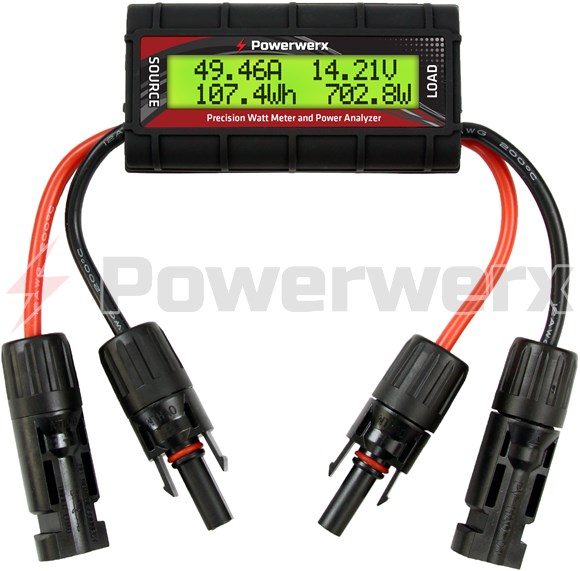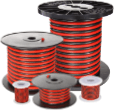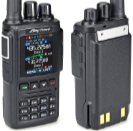
Powerwerx Watt Meter, DC Inline Power Analyzer, 45A Continuous, 12 Gauge, MC4 Solar Connectors
- $59.99
- In Stock
- SKU: WattMeter-MC4
Customer Reviews
Watt Meter w/MC4 By Guest
Great product for use where portable solar of various configurations is built and defit in a wide range of environments.
I found it to be accurate and easy to deploy.
A great buy
I found it to be accurate and easy to deploy.
A great buy
Was this review helpful? Yes No (3/0)
I agree...12 AWG is not a problem for this product By SCOTT
I've read the comments about 12 AWG versus 8 AWG for this product. My background is an Electrical Engineer with 2 decades of experience designing DC power systems. I want to voice my support for the statements made in the post "On balance…12 gauge is fine to use here." The points made are accurate and the overall message is correct. Adding 1 foot of 12 AWG wire in series in your circuit is the equivalent of adding 2.5 feet of 8 AWG wire in series. The effect will be negligible. The larger effect is that in order to make a current measurement, the device very likely uses a shunt resistor in series in the circuit. Although the value of this resistor is not specified, it is probably in the ballpark of 0.001 to 0.005 ohms for the measurement range of 0 to 100 A. Additionally, the contact resistance of each connector will also be several milli-Ohms. Amongst these contributors, you have a larger effect than the gage of the wire.
Was this review helpful? Yes No (30/2)
On balance…12 gauge is fine to use here. By Guest
10 guage would be nice, but 12 is fine. Unless you are pushing super high amperage, and most solar systems push voltage, not amps, you are not going to have trouble with this derating your system because the footage of wire here is what, under a foot in total length? That does not add a truly significant amount of resistance to your circuit for such a short run. It is not likely to significantly reduce the wattage of your system output. Don't believe me? How many ohms resistance is added by a foot of 12 gauge? .002 ohm. How many ohms resistance is added by a foot of 8 gauge? .001 ohms. So you are talking about saving only .001 ohms of resistance but increasing the cost of the product significantly to accommodate much larger gauge wires and connectors that can handle it. This is why while its true the MC4 connectors can handle up to 8 AWG wire, you will not find so many 8 gauge solar-rated wire sets with MC4 connectors preinstalled. Many MC4 crimping tools do not even crimp wire gauges over 10. The added cost of making a tool like this meter with 8 gauge wire may be not too much more to implement but manufacturers need more incentive to make a more expensive product than "it will save me .001Ω on my system wire run resistance.or the equivalent in a 1000 W system of losing .02 Watts. Such a fuss over such a negligable loss! You lose far more energy to heat derating and dirty connectors than you would to one foot of 12 gauge wire added to your otherwise 8AWG wire rated system. Now with that in perspective we can see the shrill cries for 8AWG cables on this product is silly. If it matters that much I would suggest people buy one of those and modify it with their own 8 AWG cables since most solar amateurs buying gear like this should be familiar with soldering, crimping and stripping wires. Should not be a big chore to fix this "problem" to your liking rather than just whining about it and down-rating a perfectly fine product for ridiculous technical reasons that don't really matter.
Was this review helpful? Yes No (51/1)
Increased wire gauge. You would sell a lot more of these. By Guest
Would really like to see higher gauge wire. I use 8 gauge in my system to minimize loss. You guys would sell a hell of a lot more of these if you increase the gauged wire connectors.
Was this review helpful? Yes No (28/31)
Watt meters should be made with the highest possible Gauge By Guest
Watt meters should be made with the highest possible Gauge for its intended applications so that it won’t insert loss to the circuit under test. At least they should have different gauge versions of this product. In my case I use 8 Ga. It should also have either it’s own power source to operate or compensate in the reading the power it uses from the circuit under test to operate.
Was this review helpful? Yes No (28/23)
Watt meters should include 10 Ga Version By Guest
The watt meters look like they measure all the right things. The problem is that they all have 12 Ga wire to the circuits. I use 10 ga wire in my solar system and I don't want to include 12 ga wire in that circuit.
Was this review helpful? Yes No (36/25)
Write a review of this product and share your opinion with others.




